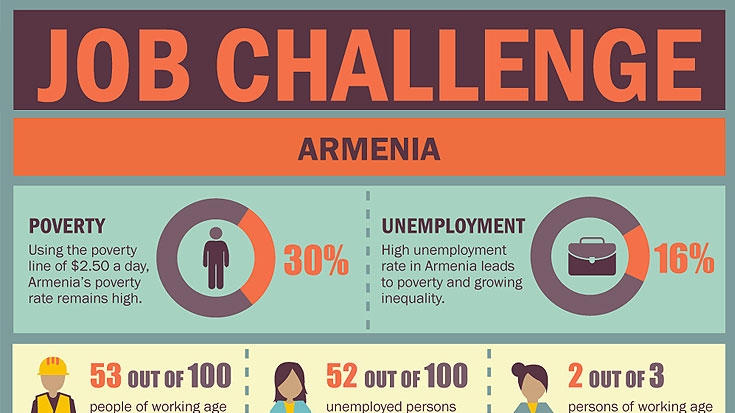The South Caucasus country of Armenia is no exception.
Using the poverty line of $2.50 a day for the Europe and Central Asia region, Armenia’s poverty rate remains high today at 30 percent. The incidence of poverty is found to be closely associated with the labor market outcomes of individuals. For example, heads-of-households who are unemployed or inactive are considerably more likely to be poor than heads-of-households who are employed. In 2010, half of the population from households where the household-head was unemployed was living below the poverty line.
In Armenia, the unemployment rate is at 16 percent today: out of 100 persons of working age (15-64 years), only 53 are employed. In addition, every other unemployed person is jobless for more than a year. The problem is not only high unemployment – but also low labor force participation. Only about two-thirds of persons of working age are employed or looking for work.
And, many of those who are employed have low-productivity jobs. These are low-paid jobs that pay less than two-thirds of the median wage. One in four jobs in Armenia is low-paid.
Labor market outcomes have a crucial impact on the risk of poverty faced by both individuals and households. The incidence of poverty is not only high among the urban unemployed, but also among low-paid workers. Informal jobs often do not prevent poverty. As a result, Armenia has a large number of working poor. High work intensity of the household is critical for avoiding poverty, but in Armenia a large proportion of households are characterized by low work intensity.
Employers claim that unfair competition by informal firms is the most detrimental impediment to job creation, as informal firms do not pay taxes and therefore have a cost advantage. Employers also view red tape and bureaucratic harassment as major obstacles, even more so than skill shortages.
By comparison, less than 10 percent of firms report labor regulations as an important obstacle to firm growth and hiring new workers. Indeed, according to the World Bank’s Doing Business indicators, hiring and firing costs are low in Armenia. This suggests that improvements in the business environment could have a significant impact on accelerating the pace of job creation and could address the root cause of high unemployment in the country.
A recent report, Back to Work: Growing with Jobs in Europe and Central Asia, set the framework for the World Bank in supporting its client countries to get both the “demand” and “supply” side right – in terms of laying the fundamentals for the private sector to thrive and create jobs, and supporting workers so that they are well equipped and unhindered to take on the new job opportunities. According to this framework, Armenia faces a number of challenges to do with job creation.
Economic Restructuring
Net job creation generally reflects the pace of economic restructuring. Armenia has made less progress in developing the policies and institutions of a market economy in comparison to some of the leading transition economies.
Governance is weaker, enterprise restructuring is less advanced, and the environment is less competitive. Paying taxes, getting electricity and trading across borders are particularly onerous. Currently, the informal sector is still prominent in the economy, with informal employment represents as much as 64 percent of total employment.
Entrepreneurship
Armenian entrepreneurs are involved in a higher level of innovation activities than entrepreneurs in Georgia – even though the firm entry density is not as high, but this may be related to the business environment. In comparison with neighboring countries, Armenian entrepreneurs attain a higher level of education; many have postgraduate degrees.
According to the World Bank’s Skills for Employment and Productivity (STEP) household survey report, entrepreneurs in urban areas have a higher income than wage earners. Entrepreneurs consider skilled labor, market risk, and access to finance as the top three barriers to successful startups.
Skilled Labor Force
Armenian workers are well educated. Only a small proportion of workers have less than secondary education and these workers are concentrated in rural areas. In urban areas, one worker in three has a tertiary education, and one worker in four has a secondary technical education.
However, the most striking feature of employment in Armenia is the high incidence of low-pay among well-educated workers. A large number of Armenian workers claim to have skills higher than those required for their jobs. In other words, their skills are not fully utilized. The STEP survey shows that the average reading proficiency scores of Armenian adults are below international standards today.
Incentives to Work
The labor force participation rate in Armenia is low, due mainly to the low economic activity of women. Only 55 percent of women of working age are economically active. Low labor force participation has necessitated further examination of the roles of labor market institutions and social benefits in providing incentives or disincentives for work.
In addition, breaking the barriers that keep people from participating in productive jobs is also crucial. There is evidence that caretaking duties in the household, lack of transportation to the work place, or lack of information about job opportunities are correlated with labor force participation rate in the country. It is worth noting that caretaking duties for household members are remarkably higher for social safety net beneficiaries and the poor in general.
-------------------------------------------------
This is the first in a series of three stories about the jobs challenge in the South Caucasus. See also:
The Jobs Challenge in the South Caucasus – Azerbaijan
The Jobs Challenge in the South Caucasus - Georgia


